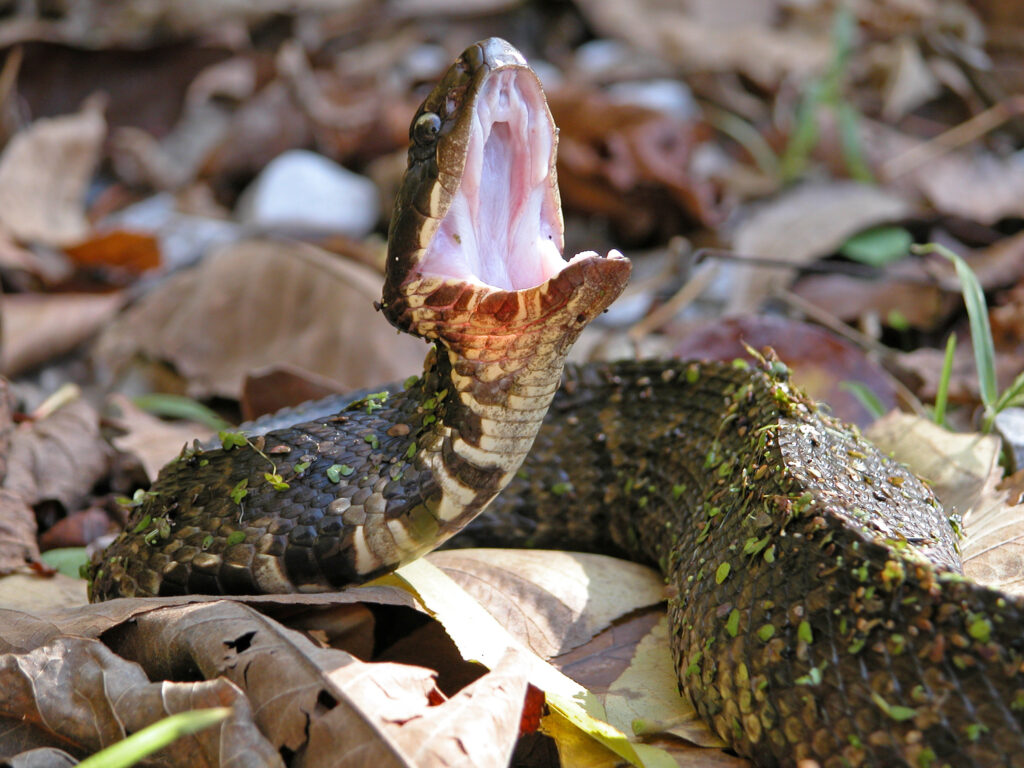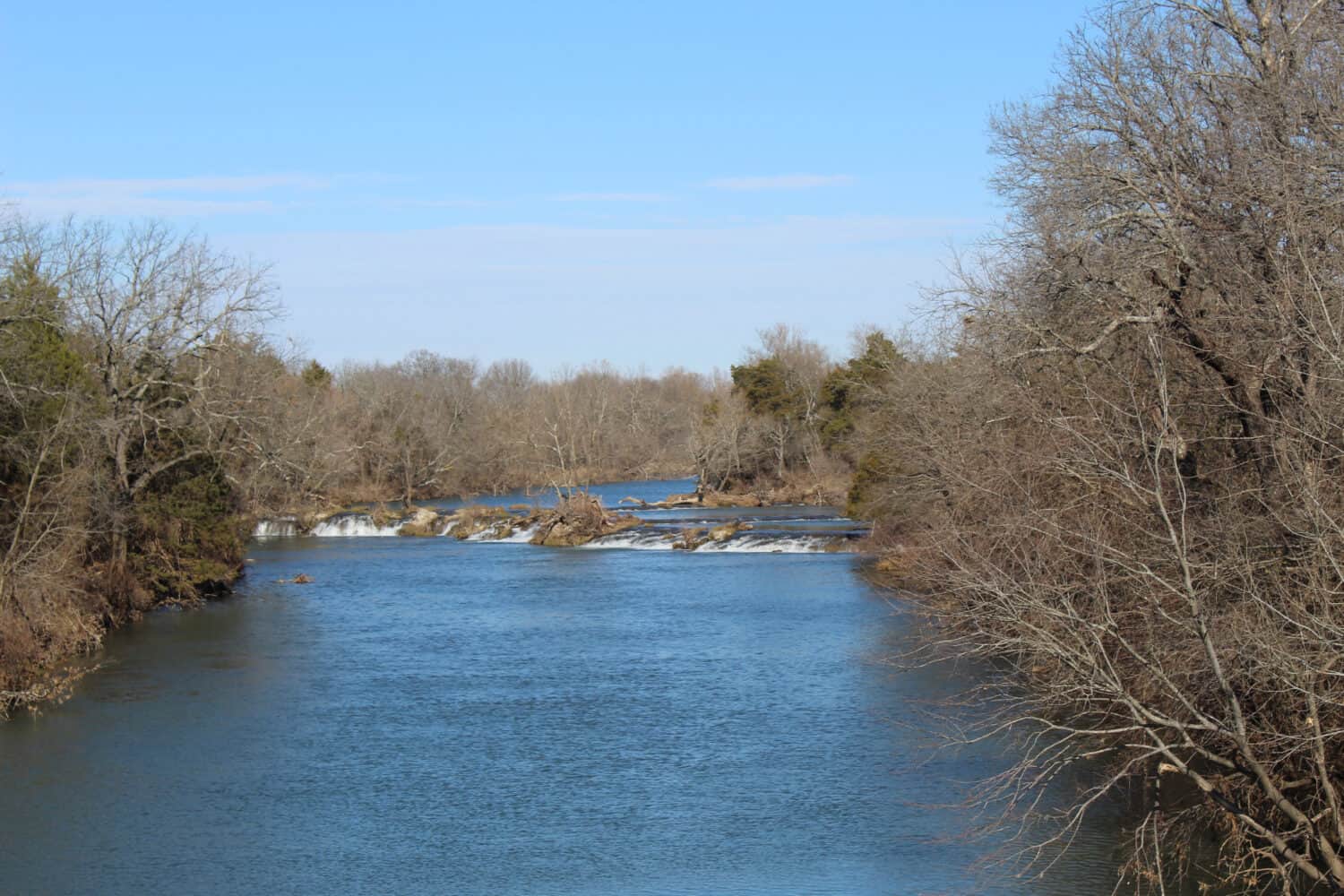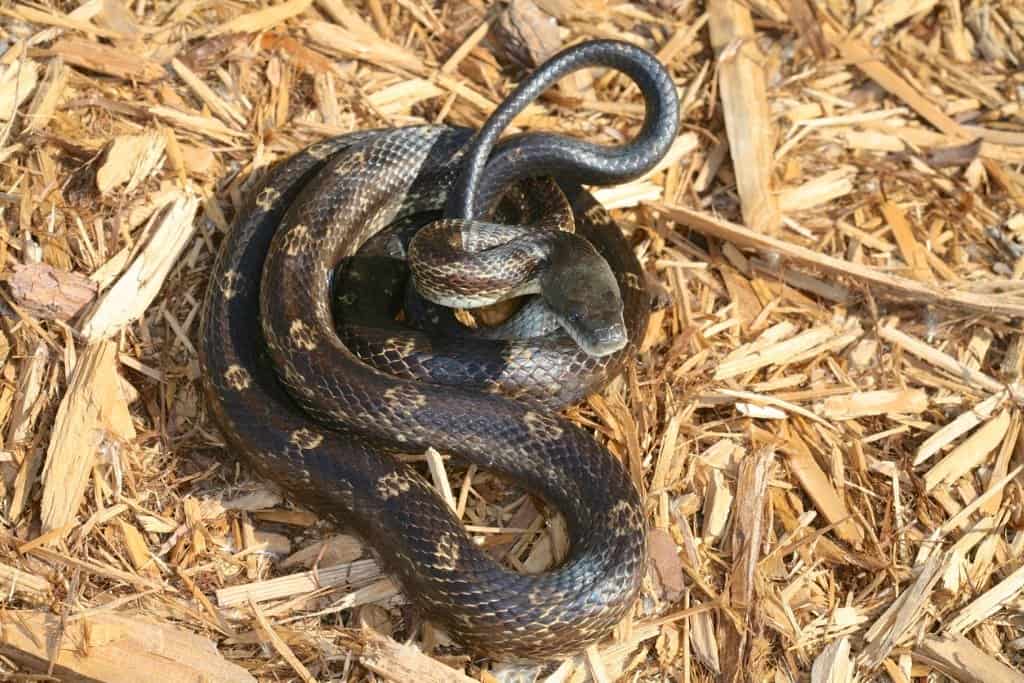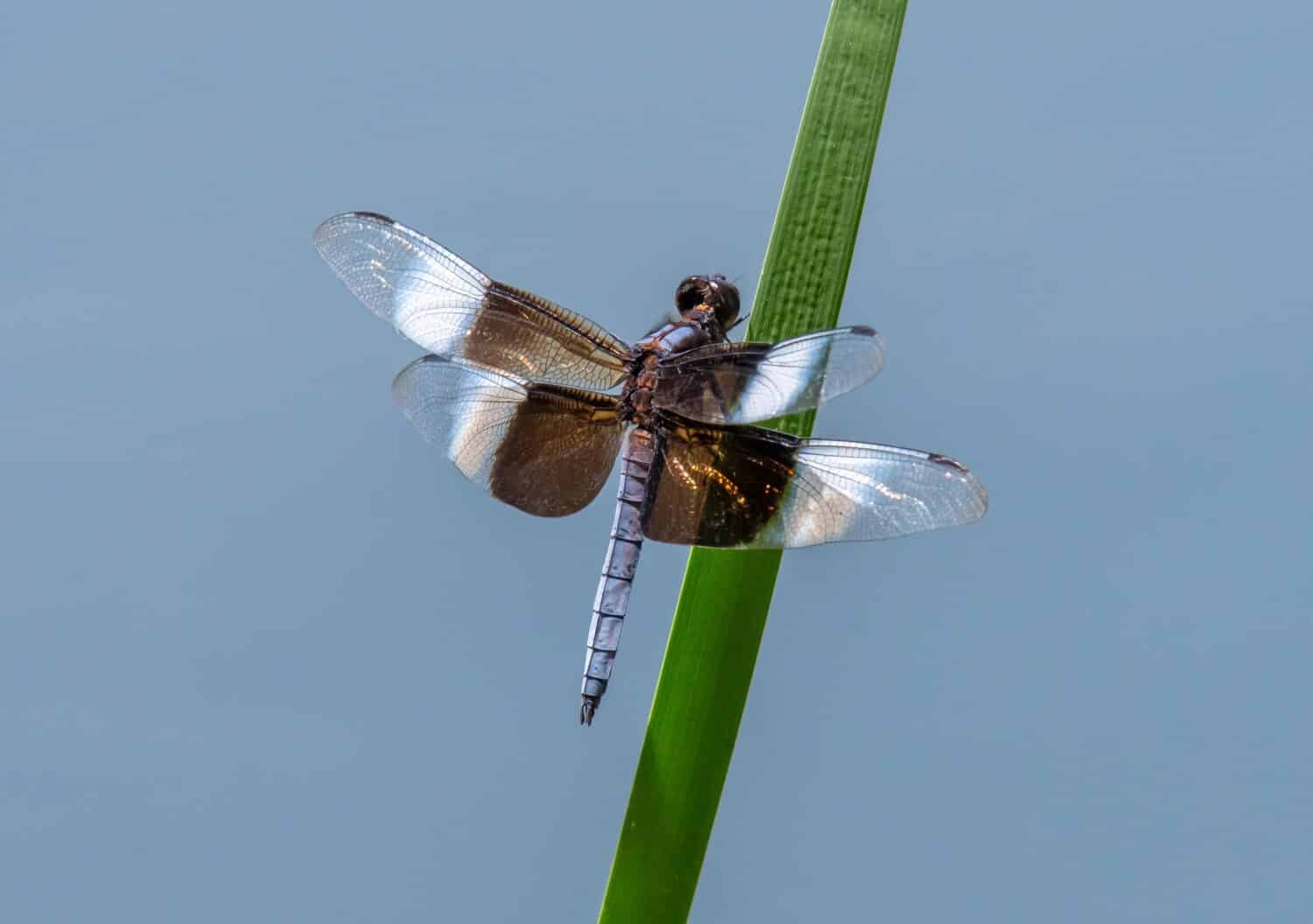
Water Snakes in Oklahoma
True water snakes are those in the Nerodia genus and include plain-bellied, diamond-backed, banded, and a few more. According to the Oklahoma Department of Wildlife Conservation’s Field Guide, Oklahoma has at least 3 of the 10 or so species native to North America.

The cottonmouth is in the subfamily Crotalinae, commonly known as pit vipers.
©iStock.com/Gerald DeBoer
People often confuse these harmless snakes with venomous cottonmouth — as adults, many of them share some characteristics, like keeled scales and stout, nearly patternless bodies. However, nothing could be further from the truth! Watersnakes are harmless. But harmless doesn’t mean docile. These snakes will not hesitate to bite viciously (hard!) and musk immediately.
Cottonmouths, on the other hand, can send you to the hospital. These venomous pit vipers are common in the eastern half of Oklahoma, in rivers, ponds, and lakes — anywhere with abundant prey and shelter. They’re generally fish and frog eaters, and their scientific name translates roughly as “hook-toothed fish eater.” However, they’ll also eat small rodents and other prey as they can catch it.
Most Snake-Infested Rivers in Oklahoma
You’re looking for the most snake-infested rivers in Oklahoma? Let’s discuss what that means. To someone afraid of snakes, seeing one in a month may be “infested.” Yet, to an avid herper, that’s not even worth the effort to get out of the house.
As with many things, the truth is somewhere in the middle. While we’re hard-pressed to say that any river in Oklahoma is truly snake-infested, there are rivers and lakes that have more snake sightings than others. Those are the rivers we’re discussing here.
Arkansas River

The Arkansas River begins in Colorado.
©iStock.com/pabradyphoto
The Arkansas River is one of the major Mississippi River tributaries and begins in Colorado. From there, it flows through Kansas and northeast Oklahoma before joining with the Mighty Mississippi on the far side of Arkansas. In Oklahoma, It’s one of the biggest rivers in Oklahoma and hosts hundreds of animal species.
Many sections of the river are covered in dense vegetation, making it a perfect home for the snakes! The most commonly spotted snake along this river is the plain-bellied watersnake. After that, you’ll probably see the infamous western ratsnake, Dekay’s brownsnakes, rough earthsnakes, western ribbon snakes, rough green snakes, diamondback watersnakes, and even a few cottonmouths. The list goes on because the river is home to most of Oklahoma’s snake species.
South Canadian River

The Canadian River’s name origin is a mystery, but its headwaters are in Colorado.
©marekuliasz/Shutterstock.com
Another river that originates in Colorado, the Canadian River is the longest tributary of the Arkansas River. It flows about 1,026 miles through New Mexico, the Texas Panhandle, then flows across central Oklahoma before it drains into the Arkansas River in eastern Oklahoma.
Most of the South Canadian River is remote. It’s rainfall dependent and often falls to low levels between storms. Also full of vegetation through much of its course, this river is home to many snakes. The most common are watersnakes of various species — plain-bellied, diamond-backed, and northern. You’ll also spot cottonmouths in the eastern half, western ratsnakes and speckled kingsnakes along most of it, and various other small snakes like ringneck snakes, Dekay’s brownsnakes, western ribbon snakes, and common garter snakes.
Red River

Most of Oklahoma’s 40+ snake species can be found
somewherealong the Red River.
©RaksyBH/Shutterstock.com
The Red River forms part of the border between Oklahoma and Texas. It begins in New Mexico, flows through the Texas Panhandle, between the two states, and onwards to the Mississippi in Louisiana. It’s popular for fishing and boating, including kayaking.
Cottonmouths are common in the eastern half, along with mudsnakes, Graham’s crayfish snake, western ratsnakes, and Dekay’s brownsnakes. However, most of the state’s 40+ snake species can be found somewhere along the Red River.
Neosho River

The Neosho River starts in Kansas and ends near Muskogee, Oklahoma.
Image: South 500 Photography, Shutterstock
©South 500 Photography/Shutterstock.com
Probably the shortest river on our list of snake-infested rivers, the Neosho River starts in Kansas, then flows south-southwest into Oklahoma, where it drains into the Arkansas River near Muskogee, Oklahoma.
This beautiful river offers kayaking, fishing, and wildlife watching. Snakes are part of the habitat! Common snakes in and around the Neosho River are plain-bellied watersnakes, speckled kingsnakes, northern watersnakes, western rat snakes, rough green snakes, and common garter snakes.

Speckled kingsnakes live around the Neosho and Colorado Rivers.
©Cherdchai Chaivimol/Shutterstock.com
Blue River

The Blue River is great for rafting and kayaking.
Image: Jena McDonald, Shutterstock
©Jena McDonald/Shutterstock.com
The Blue River starts near Connerville, Oklahoma, and flows southeast toward the Red River. It’s popular for rafting and kayaking and floating; it also boasts a few falls and ledges. Some areas of this river move too fast for watersnakes to be interested. But many spots are terrific and offer plenty of food and shelter.
Along the Blue River copperheads are more common — they’re not big swimmers, but all snakes can swim. Additionally, when it gets hot, all snakes will seek shade or water to cool their body temperatures. Common around this river are western rat snakes, flat-headed snakes, banded watersnakes, and plain-bellied watersnakes.
Summary

Western rat snakes darken as they mature and lose most of the pattern on their heads and bodies.
©iStock.com/Naja Shots
Oklahoma’s rivers have everything a snake needs to thrive: food and shelter. Whether they’re water snakes that mostly eat fish or land-loving snakes that go after rodents, the rivers and the thousands of shoreline miles offer a variety of habitats.
Summary of the Most Snake-Infested Rivers in Oklahoma
| River Name | Snakes Found | |
|---|---|---|
| 1. | Arkansas River | Plain-bellied watersnake, diamond-backed watersnake, northern watersnake, western ratsnake, cottonmouth, rough green snakes. |
| 2. | South Canadian River | Plain-bellied watersnake, western ratsnake, northern watersnake, cottonmouth (in the east), Dekay’s brownsnake. |
| 3. | Red River | Cottonmouth, plain-bellied watersnake, diamond-backed watersnake, Dekay’s brownsnake, western ratsnake, coachwhip, mudsnake. |
| 4. | Neosho River | Western ratsnake, cottonmouth, plain-bellied watersnake, northern watersnake, speckled kingsnake. |
| 5. | Blue River | Copperhead, cottonmouth, banded watersnake, western ratsnake, ring-neck snake, flat-headed snake. |
Other Animals
Of course, snakes aren’t the only animals you can spot in, on, and near Oklahoma’s rivers. The state’s river habitats support a diverse ecosystem full of different species. Here are a few animals that live in and around rivers.
Bold Jumping Spiders (Phidippus audax)
Maybe we’re a little crazy, but we think that jumping spiders are cute. Sure, some may disagree, but jumping spiders have big, friendly eyes and iridescent colors. Bold jumping spiders don’t swim, but they can live in the brush and trees along river edges.
They actively hunt prey like grasshoppers, caterpillars, and even other spiders. One of the most common spiders within its range, the bold-jumping spider also lives peacefully alongside humans. Bits are rare, but they can happen if the spider is threatened or mishandled.

These active hunters don’t build webs but instead actively stalk their prey.
©Brett Hondow/Shutterstock.com
Pond Slider (Trachemys scripta ssp.)
Pond sliders, like this red-eared slider, are common in lakes and rivers across Oklahoma. They’re nonaggressive and skittish. They’ll probably take off before you get close enough to do anything other than say, “Oh, look, a turtle!”
These omnivorous turtles grow pretty large; their carapace can reach 16 inches. They’re native to the midwestern United States but, because of pet releases, have become invasive in some non-native areas.

Red-eared slider sitting on a bed of pond grasses. These
pond turtles
have poor hearing but good vision and are very sensitive to vibrations.
©xbrchx/Shutterstock.com
Widow Skimmer (Libellula luctuosa)
This dragonfly lays its eggs in the water, where they hatch and live as nymphs until they mature enough to leave the water and develop their wings. These predators are exactly what you want hanging around when the mosquitos show up — widow skimmers and other dragonflies are known mosquito eaters.
Common throughout much of their range, widow skimmers are as beautiful as they are beneficial!

Widow skimmers are marshland-dwelling dragonflies.
©Gerald A. DeBoer/Shutterstock.com
The photo featured at the top of this post is © Tyler Albertson/Shutterstock.com
Thank you for reading! Have some feedback for us? Contact the AZ Animals editorial team.






